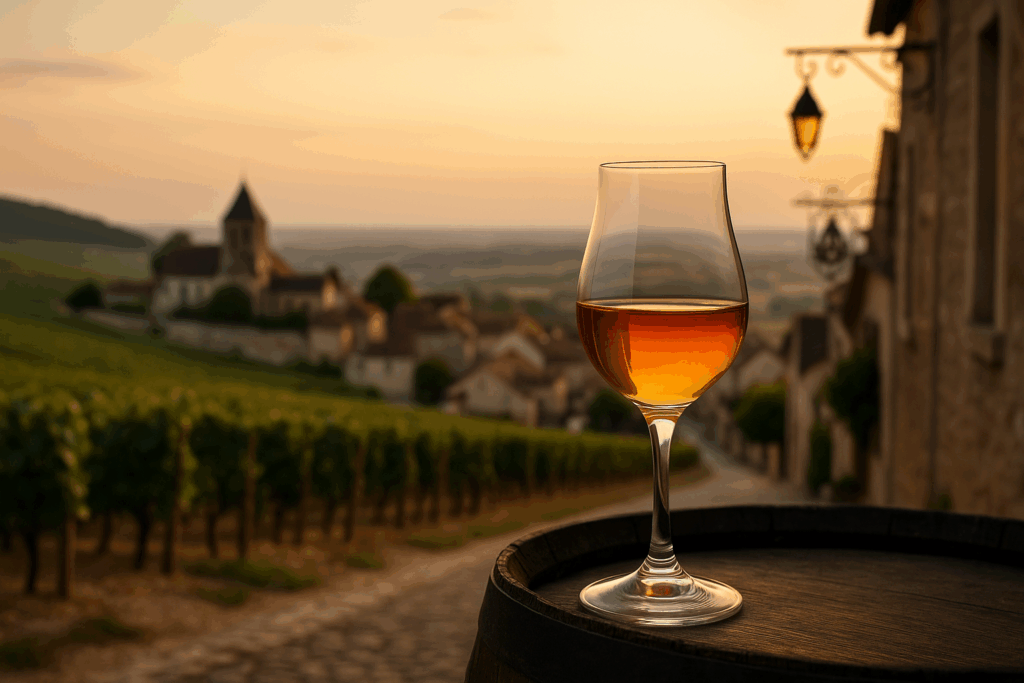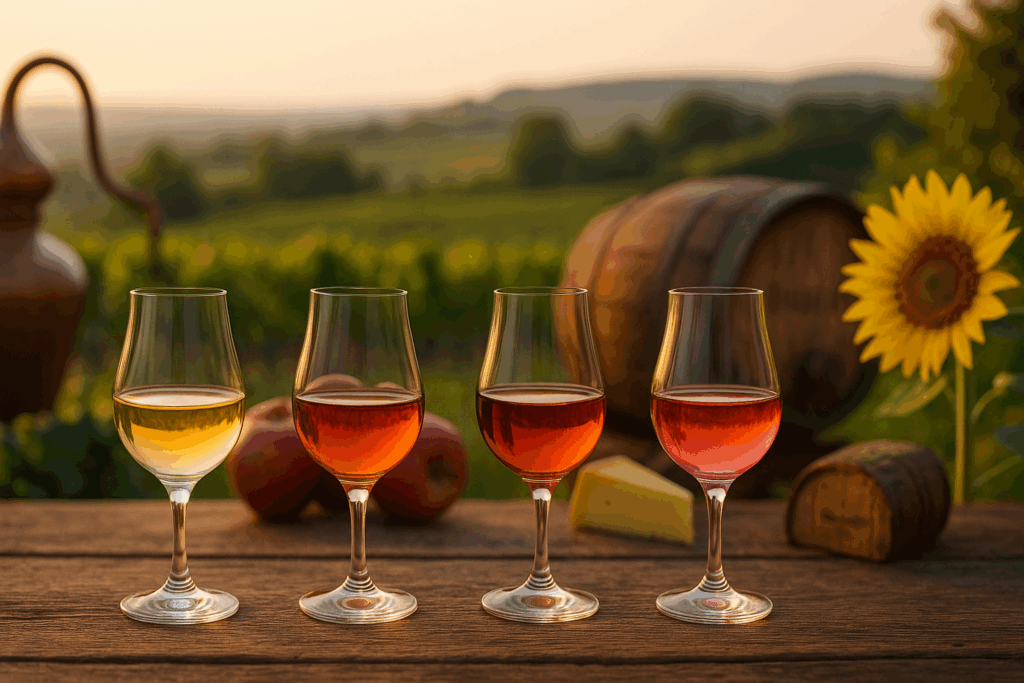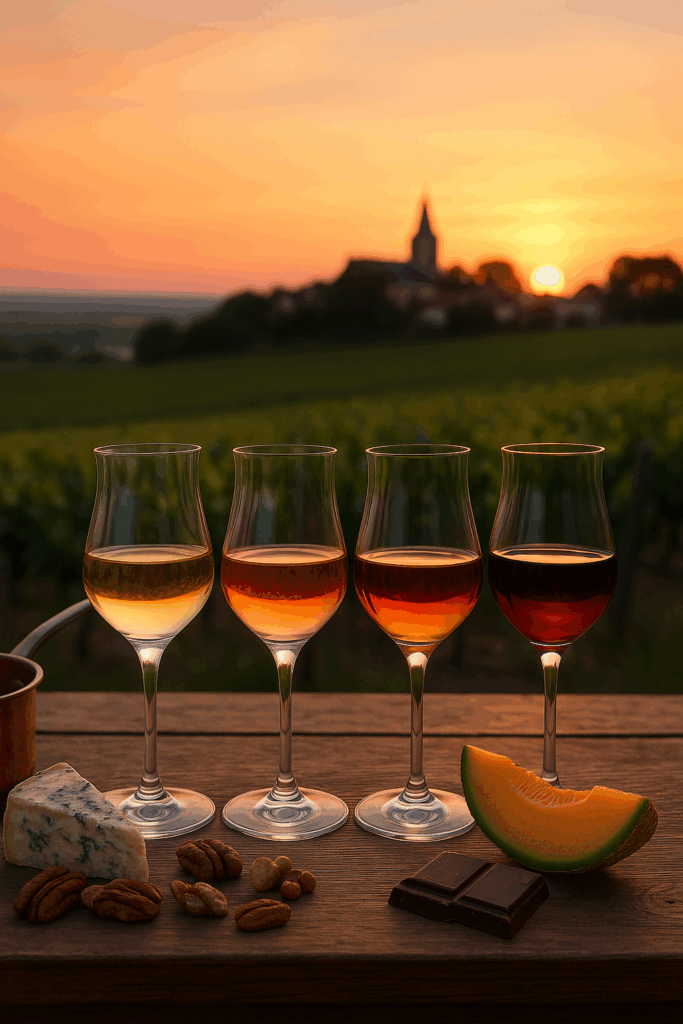VDL vs VDN: my Hautvillers discovery and 4 irresistible vins de liqueur
The champagne phase is the perfect time to get to know vin de liqueur (VDL), mistelles where grape must is immediately “muted” with alcohol, so fermentation never begins. In regulations this falls under liqueur wine with typically 15–22% vol.; with mistelle the must is unfermented and, through the addition of wine alcohol, non-fermentable.
What is VDL and why does it suit your taste?
With VDL all sweetness remains grape-derived and you add alcohol of viticultural origin. The result is round, aromatic, and ideal as an aperitif or with dessert. Think of Ratafia champenois, Pineau des Charentes, Macvin du Jura, and Floc de Gascogne.
VDL vs VDN
VDL (mistelle): you stop fermentation before it really begins; must + alcohol → sweetness from the grape.
VDN (vin doux naturel): you interrupt an ongoing fermentation by mutage (adding neutral wine alcohol). See e.g. Muscat de Beaumes-de-Venise. Read more at Franse vin doux naturel and deepen your tasting technique via wine tasting.
My encounter with Ratafia in Hautvillers
During my visit to Hautvillers I tasted Ratafia champenois for the first time, a smooth, spicy expression of Champagne must without bubbles. Officially it is a spirit drink with GI protection; it can be marketed after at least 10 months of aging (tank or barrel) or after at least 3 years in wood when stated on the label. The base is must from the Champagne region plus alcohol of viticultural origin. Want the context and atmosphere? Read about my first experience in Hautvillers (Champagne); for terroir background, dive into crus of Champagne.


Four French VDLs you’ll want to know now
Pineau des Charentes (AOP)
In Cognac country you fortify fresh must with AOC Cognac. White ages at least 18 months, of which 12 months in oak; red/rosé at least 12 months, of which 8 months in oak. By law the alcohol range is 16–22% vol. Style: from blossom and stone fruit (white) to red fruit and spiciness (red/rosé). Tip: serve chilled as an aperitif; in the kitchen Pineau shines for glazing or sauces with wine–food pairings.
Pommeau de Normandie (AOC)
Strikt genomen geen wijn, maar appel-mistelle: appelmout + Calvados, daarna min. 14 maanden eiken. Rijk aan gebakken appel, karamel en specerijen; denk aan paté, cheddar of appeldesserts. Voor regionale matches kijk je bij regional wine food pairing or play with the the art of contrast.
Macvin du Jura (AOC)
Jura does it in its own way: unfermented must (mostly white, sometimes red/rosé) is fortified with Marc du Jura. The official specifications confirm Macvin as vin de liqueur; practical guides describe about 2/3 must + 1/3 marc, with a typical 16–22% vol. Nutty, orange peel, dried fruit, wonderful with Comté or chocolate. Pair smartly via harmony of food and wine pairing
Floc de Gascogne (AOC)
Gascon aperitif: must muted with AOC Armagnac from the same estate; alcohol content is 16–18% vol. White is floral and white-fruited; rosé brings red fruit. Perfect with melon or foie gras, find ideas on food and wine pairings and work them out with harmony of color.
Here’s how to serve and pair them
Serve white/rosé at 8–10 °C, amber/red at 10–12 °C in a tulip glas. I focus in wine tasting mainly on the balance between sweetness, acidity, and alcohol: too cold masks aromas, too warm makes it heavy. In the kitchen, VDLs immediately add depth: deglaze your pan, enrich a jus, or give shine to desserts, more ideas in sauces with food and wine pairings. For your menu, build tension through the art of contrast or choose harmony of color.
Quick serving tips
- Ratafia champenois with rillette, poultry pâté, or salted almonds.
- Pineau blanc with salty nibbles; Macvin with nut tart or dark chocolate; Pommeau with tarte Tatin; Floc with melon or foie gras.
Keep tasting further
Want to experience VDL alongside VDN? Put Pineau or Floc next to a VDN from the Rhône. Outside France comparison is also worthwhile, for example with the world of port wine.

So what exactly is the difference between VDL and VDN?
VDL (vin de liqueur, mistelle) is created when you mute must with alcohol before fermentation; all sweetness comes from the grape. VDN (vin doux naturel) is fermenting juice in which you interrupt fermentation by mutage (adding wine alcohol), as in Muscat de Beaumes-de-Venise.
What is the correct name: “Ratafia de Champagne” or “Ratafia champenois”?
The official name is Ratafia champenois. The cahier des charges confirms the term and the minimum aging (10 months; or wood with specific periods). A trade article explains that the transition to exclusively “Ratafia champenois” has been confirmed by INAO/Ministry.
Which rules apply to Pineau des Charentes?
Pineau is AOP vin de liqueur: must is muted with AOC Cognac from the same estate; alcohol 16–22% vol. White ages at least 18 months, of which 12 months in oak; red/rosé at least 12 months, of which 8 months in oak.
Is Pommeau de Normandie a wine?
No. It is an AOC aperitif based on cider (mistelle): apple must + AOC Calvados (≥65% vol. at mutage), then at least 14 months of aging in oak; alcohol 16–18% vol.
What should I know about Macvin du Jura?
Macvin du Jura is an AOC vin de liqueur (white, rosé, or red) with 16–22% vol., made by muting grape must with Marc du Jura; the marc must come from the same estate. The cahier des charges and the INAO sheet provide the official framework and the style profile.
